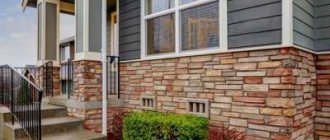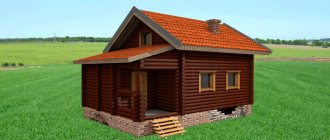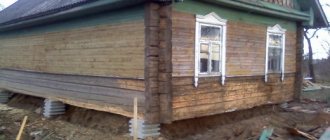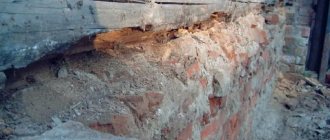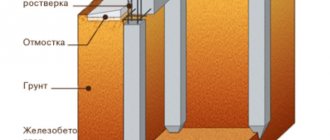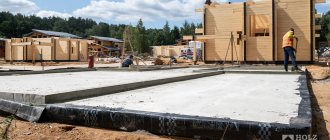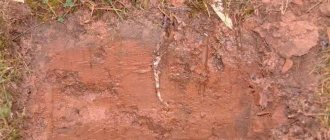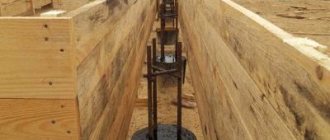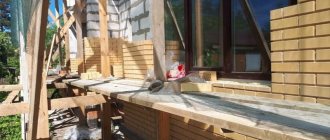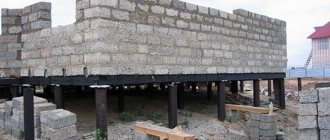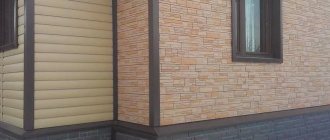The final stage of construction is finishing the basement space. In houses with pile foundations, space is left, giving an unfinished look.
In this regard, it is important to understand the finishing and study all the nuances that you should pay attention to when performing it.
Let's consider how to cover the base of a house on screw piles, the advantages and disadvantages of finishing materials.
Finishing materials
To finish the base, metal plates and wooden guides are used. Using these materials, finishing the foundation will not be difficult.
If you take metal plates with a stone pattern, then you will have a base that looks like it is trimmed with stone.
- Metal plates are attached with self-tapping screws and by welding. Welding is the most reliable and durable method of fastening the casing.
- Be sure to fill the areas where the sheathing comes into contact with the ground with sand to a depth of 30–40 cm.
- The finishing coating is leveled at the corners, the seams are sealed and sealed with a sealing liquid.
- The final job will be to fix the elements that are missing.
Important! When decorating with wood, it will need to be treated with a special antiseptic. This will prevent damage to the material.
Wall-hung finishing of the plinth
If you make a hanging finish for the base, you can’t go wrong, it has many advantages:
- material efficiency;
- quick construction and simplicity of design;
- beautiful view;
- protection from moisture.
Brick finishing
If you have the desire and finances, you can finish the basement with brick.
The advantages include such qualities as: protection from damage, thermal protection, the ability to create a basement.
Please note that this option has disadvantages: the price and the impossibility of construction on unstable and heaving soils.
Mosaic finishing
In the modern construction market, there is an unusual and expensive finishing option - mosaic plaster. This finish will please the most harmful buyer. Finishing with mosaic plaster looks very impressive, and it does not require much time and is easy to install.
Plastic finish
Plastic panels are also used to finish the basement of a house on screw piles. This is the cheapest option, but it loses in aesthetic aspects. Of course, finishing with brick or stone will look aesthetically pleasing and elite, but plastic panels are quite durable and not susceptible to chemical and weather conditions.
The range of colors and reliefs of plastic panels is quite large, and you will have the opportunity to choose what suits you.
Concrete finishing
The most economical way is to install a concrete plinth; it does not require huge costs and effort.
True, it requires finishing with plaster. After all, plaster is the best option for finishing if it is not possible to purchase more expensive materials for finishing the base.
To do this you need to do:
- basement blind area,
- then finish with moisture-resistant elements (asbestos-cement boards),
- fill the surface with sand near the base,
- then plaster the entire surface of the slabs.
There are many types of finishes and materials for this work; every person who started finishing the base will choose the ideal option for themselves. But the choice must be made with great responsibility; evaluate your physical and financial capabilities soberly.
We wish you good luck and inspiration!
Corrugated sheet
It is quite easy to attach a profiled sheet or corrugated sheet to a wooden sheathing. The frame is installed in the same way as for installing siding. The metal material with a special coating is highly durable, easy to use and operate. There are a large number of color options. But a basement structure made of corrugated sheets is not suitable for all buildings; it is important to pay attention to the cladding material of the main structure.
The principle of attaching corrugated sheets is very simple
When choosing siding, brick, panels or corrugated sheets for work, you must strictly follow the fastening technology and take into account the appearance of the building; the integrity of the facade should not be compromised.
The construction of houses on screw piles is a relatively new thing in our country, although in America it was first used in 1850 during the construction of a lighthouse. Many people are skeptical about this technology, but in its defense, the lighthouse is still standing.
Foundation on screw piles
Foundation on stilts
What are screw piles, and why is their popularity growing every year? There are many advantages, and one of the main ones is the speed of installation. Unlike a concrete foundation, a pile foundation does not require time to dry and shrink. A screw pile is a pipe with a thread on one end and a flat head on the other. Depending on the density of the soil and the features of the landscape, piles can reach 2.5 meters in length. And the wall thickness ranges from 5 mm to 15 mm. On the outside, they are coated with a special ship’s primer, which protects the metal from corrosion.
Construction of foundations on screw piles
Today, some manufacturers present their unique models of screw piles, which have minor external changes, but in fact, there are only three options:
- Piles with threaded end
- Piles with carvings throughout the “body”
- Piles with blades at the end
Of course, there is also a noticeable difference in price, and if the first two options differ only in ease of installation, then a pile with blades can significantly compact the soil around it. This is especially true in places with unstable soil and strong soil.
Facing the foundation on screw piles
To summarize, under all that has been said above, I will list several striking competitive advantages of building a house on a pile foundation:
- Ease of installation
- Possibility to use screw piles in any type of soil except rocky
- The cost is almost two times lower than that of strip concrete pouring
- Installation can also be done in winter
- Possibility of building a house on areas with difficult landscapes
- There is no need to be afraid of ground movements, even if construction is near a body of water
But, despite the obvious advantages, the foundation on screw piles has a significant difficulty, namely, how to cover the base of the house. There are several options, and to choose the right one, you need to look at each in more detail.
Base finishing options
Regardless of which option for finishing the plinth is chosen, first of all you need to take care of the supporting sheathing. Houses on a pile foundation have an air gap under the base, which must be closed. It is best to assemble the sheathing from a profile pipe with unequal sides, for example, 40/20 mm - this is not only convenient for further finishing of the base, but will also create an additional strong connection between the piles.
Important: if wood is chosen for the sheathing, then it must be well treated with impregnations and several layers of soil.
Depending on the height of the plinth, the number of sheathing guides is also calculated. There should be at least three of them, but if the height is more than a meter, then the distance should not exceed 35-40 cm between the guides. When the sheathing is ready, you can proceed to the selection of finishing materials.
Base sheathing
Basement siding
Without a doubt, siding can be considered the most popular option for finishing the basement of a house on a pile foundation. This material has practically no disadvantages, but there are a lot of advantages.
I will list only the most important ones:
- Relatively low cost. Taking into account all the components, the final cost will still not be high
- Ease of installation. You can close the basement of a house on stilts on your own, without resorting to the services of specialists
- Wear resistance. The dense plastic from which the siding is made is not subject to rotting and will last for decades.
- Huge selection of textures. Siding imitates natural materials and can be matched to the features of the landscape
- Ease of care. The base, finished with siding, can be safely washed even with the use of strong detergents
Basement siding
Facing brick
One of the most expensive ways to close the base of a house is on screw piles. In order to make brickwork you need to have certain skills, so it is better to turn to the services of specialists.
Important: in order to make reliable masonry, it is necessary to “tie” it to the pile foundation. This can be done using small metal pins, which are welded to the sheathing and subsequently embedded in the masonry.
Advantages of brickwork:
- Brick retains heat well and will not allow the base of the house to freeze even in severe frosts
- Facing brick does not require additional finishing or restoration after a few years
- The masonry creates additional support for the entire house and strengthens the pile structure
- Few materials can compete with brick in terms of durability
But, despite all the obvious advantages, there are a number of disadvantages that also cannot be ignored:
- The cost of materials and work make brickwork the most expensive option for finishing a plinth
- Construction of masonry requires a lot of time
- Variety of appearance is limited by the choice of brick color
Facing brick
Corrugated sheet
A popular material that was originally created as a roofing material, but today is used almost everywhere. You can cover the base with corrugated sheets yourself in just a few hours, and the only tools you need are a metal saw and a screwdriver.
Advantages of corrugated sheets:
- Large selection of colors
- Corrugated sheeting is a very light material and will not create additional load on the pile foundation
- Low price
- Does not require additional processing
Unfortunately, corrugated sheeting has a number of significant disadvantages that make it less attractive compared to other materials:
- Corrugated sheeting is resistant to scratches. The polymer coating is easily scratched, and corrosion begins in these places
- The appearance is limited to just one option, although it can come in different colors
- In places of contact with the soil, corrugated sheeting quickly begins to rot
- Over the course of several years, the paint fades and loses its gloss.
Finishing the base with corrugated sheets
Flat slate
Finishing the foundation on screw piles using flat slate is losing its popularity today. Slate is a capricious material, which, in addition to everything, is also recognized as harmful to human health, due to the high content of asbestos in its composition.
This option has few advantages, but for the sake of fairness they must be mentioned:
- You can make slate finishing yourself, if you have a certain set of tools.
- Slate is not subject to rotting and is insensitive to the environment
- The service life of this material is unlimited
Of course, there are many more disadvantages, and I will list only the main ones:
- Despite its density, slate is a very fragile material; the slightest inaccuracy in cutting or drilling will lead to its destruction
- Unpresentable appearance
- The cost of flat slate is somewhat higher than the cost of corrugated sheets or plastic siding
- Slate is very difficult to attach to a pile foundation
Flat slate
Conclusion
As you can see, there are many options for finishing the foundation on stilts, and most of them can be done independently. The main thing is to understand what requirements the finishing material must meet. You must approach your choice responsibly and not be guided by considerations of economy.
Other options for finishing the basement of a house on screw piles
In addition to base siding, the finishing of the base of a screw foundation can be made from other materials. At the same time, they have advantages and disadvantages, after familiarizing themselves with which, everyone chooses the appropriate option.
Brick finishing
Brick is considered a reliable building material. But to make smooth and high-quality masonry you need experience. Therefore, for such a matter it is better to use the services of professionals.
The cladding is laid on a concrete base or on a metal beam, which will serve as a support. Ventilation gaps must be left in the brickwork. The process takes time and money.
Plastic panels
This option is an affordable and quick way to finish the base. The panels are universal and can be attached to any foundation. They reliably protect against external influences, including biological and chemical. The finish is flexible and can withstand heavy loads.
Corrugated sheet
Another way to arrange a basement is corrugated sheeting. This option is not suitable for wooden and frame houses, because the material is hardly considered universal. But it is durable, perfectly protects from wind and water. It is installed on the sheathing, which makes the process quick and simple.
Flat slate
The appearance of this finish wants to be the best. But slate is used as a base for other decorative finishes, for example, tiles or special plaster.
Several options for this finish can be seen in the photos on the Internet. Asbestos cement sheets are secured with slate nails or bolts. But during installation, you need to remember that slate is quite fragile and cannot withstand strong impacts.
Cement particle board
Instead of flat cement boards, cement-bonded particle boards are chosen. They are more durable, but at the same time lightweight. They are much easier to work with. DSPs are easy to drill and trim. Nails and screws are used as fasteners. This is an excellent base for decorative material.
Moisture-resistant plywood
This is another option that is used as a basis for decoration. Plywood is suitable for the construction of frame houses. The material does not deform under the influence of water. Some craftsmen do not even apply a primer before applying the cladding.
Facing the base with stone
It doesn’t matter whether the stone is natural or artificial, but it is difficult to lay. Therefore, it is better to use the services of a professional team
The material is reliable, durable and resistant to all external influences. But natural stone will be quite expensive, and artificial stone will be cheaper.
Average prices in the Russian Federation for raw materials
The cost of clinker tiles in Russia ranges from 900-1000 rubles per square meter.
The price of corrugated sheeting, which is beneficial to use for cladding the base, varies from 400 rubles and more per square. At the same time, for a sheet measuring 1.2x2 meters you will have to pay about 1000 rubles.
Basement siding mounted on the sheathing will cost 300-600 rubles for 1 panel with dimensions 1000x500 mm. A basement thermal panel will cost from 1,300 rubles per square meter .
The cost of the material depends on the manufacturer, technical characteristics, as well as the selling company and the size of the product.
What options are the cheapest and most practical?
According to prices in stores across Russia, corrugated sheeting is the most affordable option for cladding the base of a pile-screw foundation. Its sheets are sold in individual slabs or by square meters. But this material has its own characteristics: it fades in the sun and corrodes upon contact with the ground.
Thermal panels are also a good option, as they contain insulation, but their price is too high.
The optimal solution for finishing the basement would be siding. It is easy to install, has an average price, and is not afraid of water and ultraviolet radiation. A variety of colors will allow you to find your own option.
A variety of options for finishing the basement of a private house are presented in this section.
You will find all the most important, interesting and useful information about finishing the basement in this section.
How are the pile foundations covered?
A closed pile-screw foundation is reliable protection from rodents and other animals that can live in the empty space between the piles. Also, the cladding and finishing of such a base will prevent heat loss in the home and help create a good microclimate there without excess humidity.
The most popular methods of closing a pile-screw foundation:
- creation of a suspended plinth;
- creation of a shallow tape-type base.
For a suspended plinth, thin and not too powerful composite and polymer materials, as well as wood, are used. In this case, the load on the screw piles is minimal, and the simplicity and speed of installation, coupled with low cost, is often captivating.
A suspended plinth covering the foundation with corrugated pipe piping.
However, the pile foundation will last longer when installing a shallow strip plinth, which will become the best protection for the pile frame, guaranteeing its durability.
An option for constructing a shallow base to protect the pile foundation.
Thermal and waterproofing when closing the base
All types of basement finishing require the installation of a heat- and waterproofing layer, which is covered with asbestos-cement slabs, decorative thermal panels mounted on a sheathing of boards or a slate slab, or bricks. All these materials have their pros and cons:
- Asbestos-cement boards do not look very attractive and are characterized by increased fragility, but they are inexpensive.
- Decorative panels, cement-sand or clinker tiles are resistant to atmospheric influences, and some types of them can even easily withstand high humidity. However, to lay them, a perfectly smooth and even surface is required, so the base around the perimeter will have to be covered with sheet material, for example, asbestos cement.
- It is advisable to use brick laying or pouring concrete only when the height of the above-ground part of the base is at least 30-40 cm, which allows you to equip a real basement floor.
Tying and closing screw piles is a very important stage in the construction of a house, which determines how soon it will need major repairs.
Concreting and waterproofing
In order to carry out concreting, it is necessary to purchase: reinforcing mesh, steel wire or rods, asbestos-cement slabs or boards treated with an antiseptic, formwork material and a cement-sand mixture.
It is necessary to build formwork around it, install reinforcement, and then pour it using concrete mortar.
It is imperative to insulate the basement covering from moisture. Waterproofing is laid between the base and the plinth.
If brick or stone was used to create the base surface, a layer of roofing material should be placed between the rows of masonry or bitumen should be poured. In the case of concreting, insulation is made in two layers.
For insulation, it is better to use foam sheets. They must be laid inside the structure. The insulation must exceed the height of the ceiling.
To attach the foam, you can use special glue. After laying the insulation, you should begin the final finishing. This can be done using:
- Decorative facing stone;
- Porcelain tiles;
- Clinker tiles;
- Basement siding;
- Mosaic plaster.
How to close the foundation from the outside, simulating brickwork - watch the video:
If you have already built a house and have not finished finishing the foundation, you should quickly begin to solve this problem. The house will become much warmer, it will take on a more beautiful appearance. You will feel comfort not only being inside the room, but also contemplating it from the outside.
Hello! On the website, we got a lot of ideas for decorating and building a residential building, and today we decided to repay our favorite site by presenting to the readers our version of the answer to the question: “how to cover the pile foundation of a frame house from the outside?”
When starting a construction project, we, like many other people who decided to build a house with their own hands with the minimum possible amount of money spent, chose the most budget-friendly foundation option that allows us to quickly “get down to business” - a foundation on screw piles. And once we’ve built it, we’ll think about what we’ll use to cover it with.
Time passed unnoticed. A year has flown by, the frame house is standing and blown by all the winds, siding has been ordered to finish the house, but as it turned out, another 50-60 thousand rubles need to be spent on the basement siding. according to the most conservative estimates. At that time, we did not have such funds, but after installing the fence we had sheets of corrugated sheets that were exactly the color of our metal tiles. We decided to use these sheets to cover the pile foundation from the outside.
How to finish the base of a pile foundation with your own hands
It is not difficult to do it yourself by cladding the base on screw piles, which are the basis of the frame house. A set of measures related to the finishing of a pile foundation makes it possible to solve several serious problems and involves the following stages:
waterproofing the grillage, which can be made of wood or metal;
Upon completion of the main stages of building the house, they begin finishing the base of the pile-screw foundation
- treatment of piles with a waterproofing compound;
- construction of a suspended plinth structure or lining with bricks;
- external finishing of the structure with panels that improve the appearance of the building;
- installation of special material to provide insulation;
- sealing joint areas with polyurethane foam.
Sealing the space under the building on screw supports can be done in the following way:
- hanging a decorative base;
- construction of a shallowly buried strip foundation.
Let's look at how to make a hanging option:
Form and secure the sheathing from wooden planks or metal profiles pre-impregnated with an antiseptic. Provide a distance of 10–15 cm from the bottom bar from the soil level, and an interval between vertical slats of 40–45 cm. Attach the supporting frame using self-tapping screws or welding.
The screw foundation is open to all atmospheric influences, the wind blows under the house and water flows in
- Install the insulation panels and secure them to the sheathing. It is allowed to use thermal panels intended for finishing the basement space, slabs based on asbestos cement, as well as insulation slabs used for thermal insulation of facades.
- Carefully join the corner elements and seal the joint areas. Ensure there are no gaps at all using polyurethane foam. Fix the finishing elements, install canopies that protect from precipitation.
- Perform the final finishing of the formed surface. Depending on the characteristics of the material used and personal preferences, various finishing materials, including siding, can be used for finishing cladding.
Advantages of a suspended plinth:
- insignificant level of costs compared to the construction of a strip foundation;
- easy and quick installation. Do it yourself over the course of one day;
- effective ventilation of the underground space. The design provides reliable protection from dampness and prevents the formation of mold;
- attractive appearance. Improved perception is ensured through the use of modern finishing materials.
A solid brick plinth provides not only high aesthetics of the building, but also durable and reliable protection of the underground space of the house
Let's figure out how to make a shallow version:
- Prepare a trench located along the outer perimeter of the building between the screw supports.
- Place a reinforcement cage in the pit to strengthen the strip base.
- Fill the cavity with concrete mortar and plan the supporting surface.
- Lay brick on the formed strip base. Provide vents for ventilation.
- Carry out external finishing of the surface of the formed base. Traditional stucco, siding or insulated panels may be used.
A base shallowly buried in the ground, made under a pile-screw foundation, has a number of advantages:
- increased safety margin, allowing it to withstand mechanical stress without violating integrity;
- a harmonious combination with the blind area, which can be made in the same style as the finishing of the brick base;
- the need to use insulation in a reduced amount compared to a suspended structure;
- the possibility of creating a basement under the building, protected by brickwork;
- aesthetic appearance, which is achieved by using artificial materials that are difficult to distinguish from natural stone or wood.
Finishing the base will not only make the house more beautiful, but will also extend the life of the screw piles, so it’s definitely worth doing
A shallow base also has disadvantages:
- the possibility of deformation and destruction of the finish due to soil heaving;
- increased level of costs for constructing a shallow foundation compared to the mounted option.
Choosing natural stone
This type of building and finishing material, like natural stone, is perfect for solving the problem (see also the article “Waterproofing the foundation base - we’ll protect your home”).
The main thing is to give preference to really durable stones, such as:
- granite;
- labradorite;
Advantages and disadvantages of natural stone
If we talk about the performance properties of natural stone, then first of all we should highlight such positive characteristics as:
- durability;
- naturalness;
- environmental friendliness;
- variety of colors and textures;
- highest aesthetics;
- resistance to mechanical damage;
- moisture resistance, etc.
Natural stone finishing
However, like any other material, natural stone has certain disadvantages, which are also worth mentioning:
- relatively high price;
- fairly long installation period;
- relative difficulty of care.
Installation features
The simplest option is to lay walls one brick thick between the piles, you can even use broken halves, and then cover it all with selected natural stone.
How to close and how to decorate the basement of a house on stilts from the outside?
The first stage involves creating the sheathing. This frame is necessary for further fastening of the facing material using screws or nails. The lathing consists of boards or metal profiles.
The following are the instructions:
- Installation of vertical slats. After installing the horizontal boards, the vertical ones are also installed. This will help further strengthen the structure. The installation step is 40-50 cm.
- Arrangement of a drainage cushion. A trench is dug along the perimeter of the base and filled with sand or crushed stone.
- Insulation. If you plan to insulate the base, then this procedure is performed at this stage.
- Waterproofing. A waterproofing material is installed on top of the insulation - the end of the roll should be lined with sand, and the edge should be compacted into it.
- Creating a blind area. Paving slabs are laid on top of the sand - this move helps protect the base from excess moisture.
At the final stage, panels or the selected facing material are installed. The corners must be secured with a special profile, and at the end a metal casting is installed.
If another technology for cladding the pile base was chosen, then the masonry is first made, then the surface is finished with the selected material.
Application of basement siding
If you only need to decorate the base, and no additional insulation is required, you can use siding. The material is presented in a wide range, including products with different textures and colors.
With its help, the base will take the form of a neat pedestal, with a building rising on it.
To install siding you will need:
- Clear the construction site of excess debris;
- Select soil around the outer perimeter of the house;
- Form a trench half a meter deep. It should extend slightly under the wall;
- After excavating the earth, a slight slope should form;
- Cover the entire surface of the pit with a layer of waterproofing;
- Pour crushed stone on top and lay a polyvinyl chloride drainage pipe around the perimeter;
- Draw out wells for drainage;
- Fill the trench with sand and compact it well;
- Form a blind area. It can be made from paving slabs or paving stones;
- Weld holders to the surface of the piles. Guides will be installed on them;
- Make a wooden or metal frame. To prevent wood from rotting, it must be treated with an antiseptic;
- Install siding panels;
- Install drip tides. They are needed to remove moisture.
How to close screw piles
The final stage of construction is finishing the basement space. In houses with pile foundations, space is left, giving an unfinished look.
In this regard, it is important to understand the finishing and study all the nuances that you should pay attention to when performing it. Let's consider how to cover the base of a house on screw piles, the advantages and disadvantages of finishing materials
Let's consider how to cover the base of a house on screw piles, the advantages and disadvantages of finishing materials
Let's consider how to cover the base of a house on screw piles, the advantages and disadvantages of finishing materials.
Advantages of finishing the basement space
Finishing the space between the pile foundation and the house has advantages:
- increases thermal insulation;
- prevents medium and large animals from entering under the floor;
- prevents snow and rainwater from accumulating under the house.
In order for the finishing to perform all of the listed functions, when choosing a material you need to carefully study all the advantages and disadvantages of each type.
Finishing methods
To prevent the floors in the house from being blown through, it is necessary to insulate the basement space
The open space between the soil and the floor is blown by the wind and exposed to sub-zero temperatures, resulting in a cold floor in the house. We close the piles under the house using:
- shallow strip plinth devices;
- hanging finishing material between the piles, having previously built a frame.
When choosing a finishing method and material, we consider:
- soil type;
- groundwater level;
- climatic conditions.
First of all, we install the support sheathing from a profile pipe; it will serve as a connection between the supports. The guide spacing should be 300-400 mm. The profile is selected with different side widths (40x20).
To prevent communications from freezing, we insulate them with mineral wool or foil roll insulation.
When choosing a material, we take into account that it is in contact with the surface of the earth, therefore, if water is close to it or flooded, it will be affected by all the harmful factors.
Flat slate
Asbestos boards are not an environmentally friendly material
Every year this material is losing its popularity; it is being replaced by modern, environmentally friendly materials.
Advantages:
- resistant to atmospheric influences;
- durable.
Flaws:
- asbestos is dangerous to human health and pollutes the environment;
- fragile;
- unattractive appearance.
The base of a screw foundation covered with flat slate will not harmonize with a building made from modern materials.
Blind area
The blind area insulates the base from moisture
Upon contact with soil, the quality of the facing materials is lost, so the surface must be isolated from moisture and a blind area made. For waterproofing, we use roofing felt or dense polyethylene, one end of which is tucked under the blind area, and the other edge is folded onto the frame sheathing under the finishing material.
Upon completion of the cladding, we arrange a blind area that will prevent rain and melt water from leaking under the building. To ensure the drainage of water and condensate, it must be mounted with an inclination of 1.5 degrees from the base.
Concrete is poured evenly into the formwork, in which a mesh of reinforcement is laid. We lay an expansion joint at the junction with the foundation plinth.
For more information about blind areas in a house on screw piles, see this video:
If the house is located on a slope, part of the underground can be equipped as a cellar; in this case, we provide for the installation of a door.
Laying depth
The main criterion for choosing foundation parameters is ensuring its integrity. Therefore, when planning, they always include a safety margin of about 20-40%. It compensates (to some extent) for unforeseen changes in conditions (groundwater levels, unexpectedly low winter temperatures) or loads. This is especially evident when planning foundations: the laying depth is taken with a margin and the bearing capacity is usually underestimated. This is understandable: adding something to an already finished foundation is either a very expensive or unrealistic idea.
The greatest safety margin is laid on heaving soils: it is impossible to calculate their manifestation, so they try to make it as reliable as possible. To do this, for private houses, foundations are buried below the freezing depth of the soil. You will find out the average data for your region, and add about 15-25 cm to this figure. This is how you get the depth of the foundation. For example, in the region the soil freezes to 1.5 m, which means the foundation depth is 1.65-1.75 m.
Several examples of monolithic pillars
As you understand, if you make prefabricated pillars - from brick, rubble, blocks - you will have to dig a decent size hole under each one. The bottom must be 20 cm below the laying depth to make backfill. Also, the pit should be considerably wider - you will have to work in it, folding the supports. This is another reason why monolithic pillars are made: holes are drilled under them, gravel or sand is poured onto the bottom and formwork is inserted (most often pipes of the required diameter). Inside of which a reinforcing element is installed - a frame made of reinforcement or a metal pipe.
This rule works for heavy buildings. But columnar foundations are rarely made for them. They are placed mainly under light buildings: wooden or frame houses or outbuildings. If a basement is not planned for such a building, it is more advisable to make a shallow foundation (laying depth from 0.5 to 0.7 freezing level) or shallow (from 0.3 to 0.5 freezing depth).
An example of a non-buried columnar foundation with a freezing depth of 1.2 m (1/3 of 120 cm is 40 cm)
With this choice, heaving forces will act on the pillars, but since their area is smaller than that of the tape, the impact will not be as strong. These impacts are successfully compensated by the construction of a frame or wooden house. Moreover, additional measures are being taken to reduce the impact of heaving forces:
- at the bottom of the hole under the post they make a gravel cushion, which takes on part of the load;
- make the side surfaces smooth and additionally lubricate them with grease, bitumen mastic, epoxy resin, etc.
- make an insulated blind area around the house.
As a result, in most cases, the owners do not even notice that the foundation is heaving. Some supports rose slightly, the grillage and trim compensated for them. After the ground thawed, everything returned to its place.
In soils that drain water well, the columnar foundation is made shallow or shallow
It is only important to select the correct area of the columns in order to evenly transfer the load
Versatile plants
There are indoor plants that provide many benefits no matter where they are placed.
Dracaena
A truly universal plant for the home is dracaena. It awakens vitality, excites, creates a favorable climate, positive soft energy and harmonious relationships, and protects the room. She is sensitive to the problems of her owners, and is a kind of energy barometer of your home. If suddenly your dracaena gets sick, then it would be nice to think and remember what you and your household had to face not so long ago and try to get rid of the burden of the past. Dracaena is welcome everywhere and in the bedroom too.
Ficus
Ficus trees can be placed in any room of your home. They improve the energy of the home, lift your spirits and give the room a luxurious and respectable look.
Balsam
Place balsam (Vanka wet) in the children's room. It will purify the air and help your child learn to care for plants, as he is not fussy but loves watering.
Geranium
Make sure that there is always a geranium in your house, at least one copy - then you will have no flies or moths, and the air will be fresh and to some extent disinfected. Geranium kills streptococci and staphylococci with the substances it contains. In addition, geranium placed in the bedroom has a beneficial effect on the human nervous system. In case of stress and insomnia, this plant simply needs to be kept near you.
It is better to keep a plant with red flowers in the bedroom - they help strengthen the relationship between a woman and a man. But this is only if you do not suffer from allergies. The same can be said about orchids - they cleanse the energy and improve the mood of everyone in the room who does not suffer from allergies.
Finishing with insulation
When finishing the foundation on screw piles, it is advisable to provide for its insulation. Energy saving today is more relevant than ever, and by closing the open space under the building and at the same time insulating the basement structure being built, the owner significantly reduces heat loss during the cold season.
Heat-saving cladding means a combination of external insulation with decorative finishing. The following types of materials are used as insulation:
- polystyrene foam, characterized by high thermal insulation properties and ease of installation;
- penoplex, which is durable slabs, the thickness of which varies in the range of 2 – 10 cm;
- polyurethane foam, it is one of the most effective materials for thermal insulation, but requires special expensive equipment to carry out the work;
- special facade slabs with insulation.
Extruded polystyrene foam (foam plastic) is considered the most popular and in demand for basement insulation. The principle of finishing work is similar to finishing siding. A trench is dug along the perimeter, a sheathing is attached to the piles, and insulation sheets are mounted to the elements. They can be covered with slate sheets and faced with porcelain stoneware, basement siding or plastered.
Curtain rods
A mandatory element of the design of suspended ceilings is curtain rods made of different materials. In accordance with the design of these products, they can be wall-mounted or ceiling-mounted, with the latter looking the most presentable. The complexity of their installation is due to the fact that the thin panel is not able to withstand the weight of heavy structures.
There are two ways to solve the problem with fastening the cornice:
- open;
- hidden.
After the canvas is stretched, the cornice is attached through the film to a wooden plank. Holes for self-tapping screws must be burned so that the molten edges prevent further rupture of the material.
With the hidden installation method, the cornice is fixed to the ceiling above the level of the suspended ceiling structure. A beam or corner is placed next to it for installing the guide molding. This work is performed before measurements are taken. Curtains hanging from the structure look impressive and harmoniously combine with different types of fabrics.
Base finishing options
Pile-screw foundation with a high grillage
Pile-screw base with strapping
- A pile-screw foundation with a high grillage is usually installed on unstable and moisture-saturated soils. The average length of the pile is 2.5 m, so the depth in any case will be about 2 m - in such cases, even the seasonal mobility of dispersed heaving soil is not a problem - such a depth is quite enough for immobility.
- Also, such foundations, using screw piles, are installed on slopes where the differences in the plane at different points of the base area are too large. Perhaps, in such situations, covering the base of a house on screw piles is most relevant, and here it is more convenient to use light finishing materials, for example, base siding.
Finishing work
We close the pile-screw base. Finishing principle
So, our task is to close the base for screw piles with our own hands, and for this we can use many materials. However, the essence of arranging such finishing of the basement of a house with your own hands is very similar to one another, since the principle still does not change.
The brick will be covered with ceramic tiles or simple plaster
One of the options is when the base on screw piles is sealed using a low grillage. That is, when installing such a foundation, a trench up to 30 cm deep is dug along its perimeter and a tape is poured, where the upper part protrudes 10-20 cm above the ground level. This way you get a pedestal for laying bricks, which, in turn, will serve as a base for tiles or plaster.
Here you get, as it were, two foundations in one - a screw and a strip, but this combination will not only make it possible to easily close the piles, but also increase the strength of the foundation. In addition, concrete is poured with a light reinforcement frame - as a result, the tape will not crack and will also serve as part of the decoration of the lower part of the house.
Finishing with stone panels
Another option you see in the photo above is to install sheathing on piles under some sheet material. In this case, these are stone panels, but you can just as easily install composite or siding on them. Here you see two wooden profiles, but there may be more of them - everything will depend on the height of the base and the size of the finishing material itself.
The sheathing here does not have to be installed from wood - more often it is made from metal, and for this they can use a 20x40 mm metal profile or even a CD, which is used for installing drywall.
Fixation can be done directly on the piles, but this is convenient for timber and metal, where the first is screwed and the second is welded. For CDs, it is best to weld ears (metal plates) onto the piles, onto which the brackets can be fixed.
A corner 120×120 mm serves as a base for a brick
There is another way to close the void under the building, and its price will be much less than installing a strip foundation. A corner of 120×120 mm is welded to the piles, which will serve as the basis for the facing brick, where the width of the bed is exactly 120 mm. The corner is welded strictly level and if the area is inclined, then in the upper part it is better to go deeper into the ground so that there is no void left.
Facing brick laying
Before laying decorative bricks, the corner should be primed to reduce the possibility of rusting to a minimum. The construction of the plinth is carried out as usual masonry with a spoon ligation and a seam of at least 5 mm.
After you have raised the entire perimeter, you need to put ebbs on top, which can be decorative, that is, from a brick set, or make them yourself and galvanized sheet, but the first option will look much better.
Insulation of a screw base with extruded polystyrene foam
You may also need to insulate the foundation base and for this you can use extruded polystyrene foam. A trench 20-30 cm deep and wide is dug along the perimeter of the building using a shovel bayonet and sheathing is mounted on the piles. Then you attach sheets of insulation on top of which you can lay tiles or cover them with slate sheets, as shown in the photo.
Paying homage to the brick
If you still haven’t decided how to cover the base of a house on screw piles, and you don’t have the desire or time to bother with digging a trench, there is a simpler way to design the base of a pile foundation - reliable, inexpensive, quickly erected - brickwork. A metal corner profile is welded to the foundation piles, covered with a protective film against rust, at the very bottom. A corner with a shelf width of 120 mm and a length from 6 m to 11.7 m is pre-treated with a protective anti-corrosion compound.
Facing bricks are laid on the lower profile, starting from the corners. Rising up along the perimeter, masonry is formed with a spoon bandage and seams of at least 0.05 cm. To prevent water from entering from above, ebbs are made on the lined base. It is better if they are decorative, but you can use elements made of galvanized sheet. The result is a neat, complete foundation. Visually and in terms of cost, it even outperforms a traditional concrete base.
Problems in the absence of insulation
Whatever the design features of the piles, the option and technology of their installation, this type of foundation has many disadvantages:
- Cold underground, causing significant heat loss during frosts through open space.
- When the grillage is reinforced concrete, it forms a significant cold storage tank. If you do not constantly heat the room, it is not easy to restore a comfortable microclimate in it.
- Freezing of pipelines laid underground is possible.
- Piles anchored in the frost layer can be pushed out. They are an excellent conductor of cold. When insulation measures are not carried out, concrete or metal pillars become the cause of local heaving.
- If some piles are located at points with low soil density, uneven shrinkage of the building occurs.
- Aesthetically, an undecorated foundation of this type looks unattractive.
- The underground space will certainly become littered, so it has to be cleaned periodically.
Interior design
The three-dimensional image of multidimensional ceramics allows you to create a unique interior design. This is truly an immersion into the enchanting world of paintings come to life, and for each room the theme will correspond to the aesthetics of the interior.
Kitchen
The kitchen area is more susceptible to contamination by grease stains and fumes than others. To maximize the service life of a multidimensional coating, you should choose the right textures. So, for a kitchen apron near the stove and sink, ordinary 3D ceramics and stereo tiles, matched to the tone of the entire interior, are most suitable.
Unlike embossed tiles, flat tiles make it easy to clean by wiping the surface as needed with regular detergents. But the relief surface will inevitably collect dirt from evaporation above the stove and limescale from moisture.
You can choose a large pattern for the kitchen panel that matches the color scheme and theme of the overall design of the room. These can be macro images of ripe berries, flower buds, bright abstract figures.
Hallway
A multidimensional image with perspective is an excellent opportunity to visually expand a small hallway or a long narrow corridor. Walls with “live” light landscapes, photographs of roads and streets will create a feeling of freedom of space and add light and air to the room.
If the size of the hallway or hall allows you not to save square meters, then the multidimensional image can contain both macro-pictures and a relief texture for every taste
However, it should be remembered that large images of people, animals, cars - anything that draws too much attention to itself can quickly become boring. Therefore, it is still better to choose a calm landscape theme
Living room
Relief 3D coating is the most fashionable option today for cladding the walls of a state hall or a more modest living room. Stylish wavy pattern, the effect of woven fabric, quilted or crumpled fabric, honeycomb – the choice is huge, and everyone can choose something original that suits their unique interior.
White and black 3D tiles will look perfect in a classic interior and art deco style. Warm wood shades suit both strict classics and eco and country styles.
Bedroom
Since the recreation room does not involve bright decorations or impressive multi-dimensional paintings covering the entire wall, and the landscape perspective can deprive the bedroom of comfort, designers recommend using opaque 3D relief tiles for tiling this room.
Bathroom
It is perhaps difficult to think of a more suitable place for the amazing world created by stereo tiles with a multidimensional effect than the bathroom. Manufacturers offer a huge variety of marine and beach themed options, and these products are in demand. And it’s not surprising, because it’s so nice to feel like you’re on a sunny beach under palm trees or immersed in a fascinating underwater world with corals and goldfish.
Dolphins frolicking on the waves or a mountain waterfall will calm you down after a hard day, and taking a hot bath will truly be a heavenly pleasure.
As with kitchen decor, textured tiles in the bathroom can be a hassle to clean.
Evaporating moisture will settle in the folds of the relief in the form of limescale, which not only spoils the appearance of the coating, but can also cause bacteria and fungus to appear. Therefore, in a small bathroom, from a practical point of view, it would be better to choose glass stereo tiles or 3D ceramics.
The main advantages of pile-screw foundations
This method of creating a foundation is chosen when it is not possible to create a regular strip foundation using a cement-sand mixture. In addition, there are a number of other positive nuances:
- The root system of all plantings around is preserved.
- There is no need to set up a huge construction site.
- Suitable option for marshy soils.
- Work is carried out at any time of the year, including winter.
- The pile is reused.
- Small and medium-sized elements can be installed without the help of special devices.
- Allows you to place the house in close proximity to other residential buildings.
This option for arranging the foundation is also suitable for small country cottages. The work is completed quickly and there is no need to wait until the solution is completely dry, and this greatly reduces construction time.
How is the base of a pile foundation constructed?
In order to construct a plinth for a pile foundation, you must do the following:
- Make a sheathing. To do this, use wooden blocks or a metal profile.
- Insulate. This stage can be skipped, but if you plan to use the space as a full-fledged basement floor, then it is impossible to do without thermal insulation.
- Install finishing on the screw foundation of the house.
- Seal corners and seams.
- If necessary, clean the structure and additionally treat it with special compounds.
Mounting surface
Impregnation of wood with oil
Depending on the base: wood, concrete or metal, you choose how to cover the foundation. If everything is clear with concrete, then metal, due to its technical characteristics, must be ventilated. This also applies to wood; in a damp place, their service life is noticeably reduced.
Particular attention is paid to preparing this kind of foundation. For example, wood is impregnated with a special composition that protects it from rotting and fire
GF-021 – anti-corrosion primer
Bioprotective measures are also carried out, since untreated pillars are an excellent breeding ground for insects, which will render the entire wooden structure unusable in a couple of years.
Metal is treated with red lead compounds and special anti-corrosion primers. For such purposes, you can use a regular compressor with a spray gun. It’s not difficult to do this with your own hands. By diluting the soil, for example GF-021, to the desired consistency, you can carry out all the preparatory work on metal in one day.
Plastic panels
Attaching materials to piles is carried out using the same technology as in the case of siding. If you cover the space under the house with panels, you can get the following benefits:
- attractive appearance;
- a wide range of colors and textures (you can choose imitation brick or natural stone);
- rigidity;
- resistance to mechanical and chemical influences;
- resistance to rotting;
- affordable price.
Plastic plinth panels
But when choosing, it is worth remembering that despite the efforts of manufacturers, natural brick or stone looks better than finishing made from artificial materials.
Flat slate
Previously, flat slate was used in almost any type of decoration. Now this option is used in rare cases, as it is considered unreliable. Among the main advantages it is worth highlighting:
- possibility of self-installation if you have a special set of tools;
- increased resistance to decay and negative environmental influences;
- slate allows the use of thermal panels for insulation;
- practically unlimited service life.
However, this type has a large number of disadvantages. The main ones worth highlighting are:
- Increased fragility of the material. It is quite dense, but if it is cut incorrectly or drilled poorly, the slate crumbles and is destroyed.
- Increased complexity of fastening to piles.
- The price of flat slate is significantly higher than most other materials.
- Requires additional work using other materials to give the slate a presentable appearance.
You can lay this kind of slate yourself
Hanging structure
Making a hanging structure is not difficult. You just need to follow the order:
A sheathing is created from metal corners, pipes or wooden boards.
- Guides are attached to the piles using any convenient method (with self-tapping screws or welding). This could be a metal profile, wooden beams; a kind of frame for fixing panels or asbestos-cement slabs, combined systems with insulation or slate sheets on it.
- Before installation, a “cushion” of sand up to half a meter thick is poured around the perimeter.
- Corners are formed in a convenient way using accompanying components.
- All seams are sealed with a sealed solution.
- The design is complemented by the installation of ebbs and other elements that are missing for the finished design of the base.
- The crowning achievement is the finishing decorative finish.
